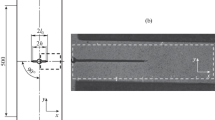A procedure for acquiring and analyzing digital fatigue crack propagation images is advanced, which provides automatic crack size detection and the deviation from the axis perpendicular to the loading direction. The procedure is based on comparing the original image with the subsequent ones and eliminating all elements present, only getting the changes in the fatigue crack extension. A slight shift of the images concerning each other was fixed with their cross-correlation. Choosing an optimum image segmentation level permits rejecting the elements that appear due to the digital matrix noise. The four-dimensional pixel assembly was used to get the geometric elements. As a result, a set of geometric figures characterizing the fatigue crack propagation was obtained. For analyzing the length and direction of crack components, the ellipses were applied whose second moments coincide with those of the components. The total change in the crack propagation direction and length is determined from the parameters of the vector connecting the centers of mass of the first and last components. The advanced procedure can be employed in crack resistance tests.






Similar content being viewed by others
References
ASTM Code, E647-95a, Standard Test Method for Measurement of Fatigue Crack Growth Rates, American Society for Testing and Materials, Philadelphia (1995).
A. Mohan and S. Poobal, “Crack detection using image processing: A critical review and analysis,” Alexandria Eng J, 57, No. 2, 787–798 (2018). https://doi.org/10.1016/j.aej.2017.01.020
Y. Zhang, “The design of glass crack detection system based on image pre-processing technology,” in: Proc. of Information Technology and Artificial Intelligence Conference (2014), pp. 39–42.
R. S. Adhikari, O. Moselhi, and A. Bagchi, “Image-based retrieval of concrete crack properties for bridge inspection,” Automat Constr, 39, 180–194 (2014).
S. Y. Alam, A. Loukili, F. Grondin, and E. Rozière, “Use of the digital image correlation and acoustic emission technique to study the effect of structural size on cracking of reinforced concrete,” Eng Fract Mech, 143, 17–31 (2015).
I. Shivprakash and K. Sinha Sunil, “A robust approach for automatic detection and segmentation of cracks in underground pipeline images,” Image Vis Comput, 23, No. 10, 931–933 (2005).
M. Rodríguez-Martín, S. Lagüela, D. González-Aguilera, and J. Martínez, “Thermographic test for the geometric characterization of cracks in welding using IR image rectification,” Automat Constr, 61, 58–65 (2016).
W. S. M. Brooks, D. A. Lamb, and S. J. C. Irvine, “IR reflectance imaging for crystalline Si solar cell crack detection,” IEEE J Photovolt, 5, No. 5, 1271–1275 (2015).
M. Vidal, M. Ostra, N. Imaz, et al., “Analysis of SEM digital images to quantify crack network pattern area in chromium electrodeposits,” Surf Coat Technol, 285, 289–297 (2016).
G. Deng and T. Nakanishi, “Practical methods for crack length measurement and fatigue crack initiation detection using ion-sputtered film and crack growth characteristics in glass and ceramics,” in: C. Sikalidis (Ed.), Advances in Ceramics – Characterization, Raw Materials, Processing, Properties, Degradation and Healing, InTech (2011). https://doi.org/10.5772/22594
O. M. Herasymchuk and O. V. Kononuchenko, "Peculiarities of short fatigue crack growth from a blind hole in specimens made of steel 45. Part 1. Experimental results,” Strength Mater, 53, No. 2, 213–221 (2021). https://doi.org/10.1007/s11223-021-00277-z
R. Draelos, Convolution vs. Cross-Correlation. https://glassboxmedicine.com/2019/07/26/convolution-vscross-correlation/
Author information
Authors and Affiliations
Corresponding author
Additional information
Translated from Problemy Mitsnosti, No. 5, pp. 103 – 111, September – October, 2023.
Rights and permissions
Springer Nature or its licensor (e.g. a society or other partner) holds exclusive rights to this article under a publishing agreement with the author(s) or other rightsholder(s); author self-archiving of the accepted manuscript version of this article is solely governed by the terms of such publishing agreement and applicable law.
About this article
Cite this article
Byalonovych, A.V. Digital Material Surface Image Analysis for Evaluating Geometric Fatigue Crack Parameters. Strength Mater 55, 960–966 (2023). https://doi.org/10.1007/s11223-023-00587-4
Received:
Published:
Issue Date:
DOI: https://doi.org/10.1007/s11223-023-00587-4



